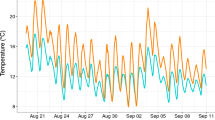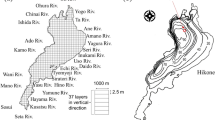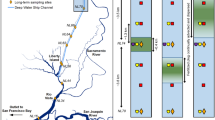Abstract
Global warming and excess nitrogen deposition can exert strong impacts on aquatic populations, communities, and ecosystems. However, experimental data to establish clear cause-and-effect relationships in naturally complex field conditions are scarce in aquatic environments. Here, we describe the design and performance of a unique outdoor enclosure facility used to simulate warming, increased nitrogen supply, and both factors combined in a littoral freshwater wetland dominated by common reed, Phragmites australis. The experimental system effectively simulated a 2.8 °C climate warming scenario over an extended period, capturing the natural temperature variations in the wetland at diel and seasonal scales with only small deviations. Excess nitrogen supply enhanced nitrate concentrations especially in winter when it was associated with increased concentration of ammonium and dissolved organic carbon. Nitrogen also reduced dissolved oxygen concentrations, particularly in the summer. Importantly, by stimulating biological activity, warming enhanced the nitrogen uptake capacity of the wetland during the winter, emphasizing the need for multifactorial global change experiments that examine both warming and nitrogen loading in concert. Establishing similar experiments across broad environmental gradients holds great potential to provide robust assessments of the impacts of climate change on shallow aquatic ecosystems.



Similar content being viewed by others
References
Aronson EL, McNulty SG (2009) Appropriate experimental ecosystem warming methods by ecosystem, objective, and practicality. Agric For Meteorol 149:1791–1799
Baulch HM et al (2003) Climate warming experiments: design of a mesocosm heating system. Limnol Oceanogr Method 1:10–15
Baulch HM, Schindler DW, Turner MA, Findlay DL, Paterson MJ, Vinebrooke RD (2005) Effects of temperature on benthic communities in a boreal lake: implications of climate warming. Limnol Oceanogr 50:1377–1392
Bellard C, Bertelsmeier C, Leadley P, Thuiller W, Courchamp F (2012) Impacts of climate change on the future of biodiversity. Ecol Lett 15:365–377
Buesing N, Gessner MO (2006) Benthic bacterial and fungal productivity and carbon turnover in a freshwater marsh. Appl Environ Microbiol 72:596–605
Burgin AJ, Hamilton SK (2007) Have we overemphasized the role of denitrification in aquatic ecosystems? A review of nitrate removal pathways. Front Ecol Environ 5:89–96
Canadell JG et al. (2007) Contributions to accelerating atmospheric CO2 growth from economic activity, carbon intensity, and efficiency of natural sinks. Proc Natl Acad Sci USA 104:18866–18870
Carpenter SR, Caraco NF, Correll DL, Howarth RW, Sharpley AN, Smith VH (1998) Nonpoint pollution of surface waters with phosphorus and nitrogen. Ecol Appl 8:559–568
Christensen MR, Graham MD, Vinebrooke RD, Findlay DL, Paterson MJ, Turner MA (2006) Multiple anthropogenic stressors cause ecological surprises in boreal lakes. Glob Change Biol 12:2316–2322
Compton JE et al (2011) Ecosystem services altered by human changes in the nitrogen cycle: a new perspective for US decision making. Ecol Lett 14:804–815
Dang CK, Schindler M, Chauvet E, Gessner MO (2009) Temperature oscillation coupled with fungal community shifts can modulate warming effects on litter decomposition. Ecology 90:122–131
Deegan LA, Johnson DS, Warren RS, Peterson BJ, Fleeger JW, Fagherazzi S, Wolheim WM (2012) Coastal eutrophication as a driver of salt marsh loss. Nature 490:388–394
DEV (2012) Deutsche Einheitsverfahren zur Wasser-, Abwasser- und Schlammuntersuchung. Wasserchemische Gesellschaft in the Gesellschaft Deutscher Chemiker und Normenausschuss Wasserwesen (NAW). Beuth, Berlin
Dunne JA, Saleska SR, Fischer ML, Harte J (2004) Integrating experimental and gradient methods in ecological climate change research. Ecology 85:904–916
Elser JJ, Anderson T, Baron JS, Bergström A, Jansson M, Kyle M, Nydick KR, Steger L, Hessen DO (2009) Shifts in lake N:P stoichiometry and nutrient limitation driven by atmospheric nitrogen deposition. Science 326:835–837
Feuchtmayr H et al (2009) Global warming and eutrophication: effects on water chemistry and autotrophic communities in experimental hypertrophic shallow lake mesocosms. J Appl Ecol 46:713–723
Fraser LH, Henry HAL, Carlyle CN, White SR, Beierkuhnlein C, Cahill JF Jr, Casper BB, Cleland E, Collins SL, Dukes JS, Knapp AK, Lind E, Long R, Luo Y, Reich PB, Smith MD, Sternberg M, Turkington R (2013) Coordinated distributed experiments: an emerging tool for testing global hypotheses in ecology and environmental science. Front Ecol Environ 11:147–155
Galloway JN et al (2008) Transformation of the nitrogen cycle: recent trends, questions, and potential solutions. Science 320:889–892
Greig HS, Kratina P, Thompson PL, Palen WJ, Richardson JS, Shurin JB (2012) Warming, eutrophication, and predator loss amplify subsidies between aquatic and terrestrial ecosystems. Glob Change Biol 18:504–514
Gulis V, Rosemond AD, Suberkropp K, Weyers HS, Benstead JP (2004) The effect of nutrient enrichment on decomposition of wood and associated microbial activity in streams. Freshw Biol 49:1437–1447
Hillebrand H, Sommer U (2000) Effect of continuous nutrient enrichment on microalgae colonizing hard substrates. Hydrobiologia 426:185–192
Jeppesen E et al (2005) Lake responses to reduced nutrient loading—an analysis of contemporary long-term data from 35 case studies. Freshw Biol 50:1747–1771
Jeppesen E et al (2010) Interaction of climate change and eutrophication. In: Kernan M, Battarbee R, Moss B (eds) Climate change impacts on freshwater ecosystems. Blackwell, Oxford, pp 119–151
Kenward MG, Roger JH (1997) Small sample inference for fixed effects from restricted maximum likelihood. Biometrics 53:983–997
Langley JA, Megonigal JP (2010) Ecosystem response to elevated CO2 levels limited by nitrogen-induced plant species shift. Nature 466:96–99
Langley JA, Sigrist MV, Duls J, Cahoon DR, Lynch JC, Megonigal JP (2009) Global change and marsh elevation dynamics: Experimenting where land meets sea and biology meets geology. In: Lang MA, MacIntyre IG, Rutyler K (eds) Proceedings of the Smithsonian Marine Sciences Symposium, vol 38. Smithsonian, Washington D.C., pp 391–400
Liboriussen L et al (2005) Global warming: design of a flow-through shallow lake mesocosm climate experiment. Limnol Oceanogr Method 3:1–9
Livingstone DM, Padisak J (2007) Large-scale coherence in the response of lake surface-water temperatures to synoptic-scale climate forcing during summer. Limnol Oceanogr 52:896–902
Lund JWG, Reynolds CS (1982) The development and operation of large limnetic enclosures in Blelham Tarn, English Lake District, and their contribution to phytoplankton ecology. In: Round FE, Chapman D (eds) Progess in Phycological Research, vol 1. Biopress, Bristol, pp 1–65
Lutz BD, Mulholland PJ, Bernhardt ES (2012) Long-term data reveal patterns and controls on stream water chemistry in a forested stream: Walker Branch, Tennessee. Ecol Monogr 82:367–387
Macháčová K (2010) Open top chamber and free air CO2 enrichment—approaches to investigate tree responses to elevated CO2. iForest Biogeosci For 3:102–105
McKee D et al (2003) Response of freshwater microcosm communities to nutrients, fish, and elevated temperature during winter and summer. Limnol Oceanogr 48:707–722
Megonigal JP, Hines ME, Visscher P (2004) Anaerobic metabolism: linkages to trace gases and aerobic processes. In: Schlesinger WH (ed) Biogeochemistry. Elsevier-Pergamon, Oxford
Mikkelsen TN et al (2008) Experimental design of multifactor climate change experiments with elevated CO2, warming and drought: the CLIMAITE project. Funct Ecol 22:185–195
Morgan JA, LeCain DR, Pendall E, Blumenthal DM, Kimbal BA, Carrillo Y, Williams DG, Heisler-White J, Dijkstra FA, West M (2011) C4 grasses prosper as carbon dioxide eliminates desiccation in warmed semi-arid grassland. Nature 467:202–205
Odum WE (1988) Comparative ecology of tidal freshwater and salt marshes. Annu Rev Ecol Syst 19:147–176
O’Reilly CM, Alin SR, Plisnier P, Cohen AS, McKee BA (2003) Climate change decreases aquatic ecosystem productivity of Lake Tanganyika, Africa. Nature 424:766–768
Ramanathan V, Feng Y (2008) On avoiding dangerous anthropogenic interference with the climate system: Formidable challenges ahead. Proc Natl Acad Sci USA 105:14245–14250
Riebesell U, Lee K, Nejstgaard JC (2010) Pelagic mesocosms. Guide to best practices in ocean acidification research and data reporting. Office of the European Union, Luxembourg, pp 81–98
Rowlands DJ et al (2012) Broad range of 2050 warming from an observationally constrained large climate model ensemble. Nat Geosci 5:256–260
SAS (2002) SAS Institute, Cary NC, USA
Scheiner SM, Gurevitch J (2001) Design and analysis of ecological experiments. Oxford University Press, New York
Schindler DW (2006) Recent advances in the understanding and management of eutrophication. Limnol Oceanogr 51:356–363
Shurin JB, Clasen JL, Greig HS, Kratina P, Thompson PL (2012) Warming shifts top-down and bottom-up control of pond food web structure and function. Philos Trans R Soc Lond B 367:3008–3017
Slavik K, Peterson BJ, Deegan LA, Dowden WB, Hershey AE, Hobbie JE (2004) Long-term responses of the Kuparuk River ecosystem to phosphorus fertilization. Ecology 85:939–954
Solomon S, et al (eds) (2007) Contribution of Working Group I to the Fourth Assessment Report of the Intergovernmental Panel on Climate Change. Cambridge University Press, Cambridge
Townsend AR et al (2003) Human health effects of a changing global nitrogen cycle. Front Ecol Environ 1:240–246
Vinebrooke RD et al (2004) Impacts of multiple stressors on biodiversity and ecosystem functioning: the role of species co-tolerance. Oikos 104:451–457
Vitousek PM et al (1997) Human alteration of the global nitrogen cycle: sources and consequences. Ecol Appl 7:737–750
Wernberg T, Smale DA, Thomsen MS (2012) A decade of climate change experiments on marine organisms: procedures, patterns and problems. Glob Change Biol 18:1491–1498
Woodward G, Perkins DM, Brown LE (2010) Climate change and freshwater ecosystems: impacts across multiple levels of organization. Philos Trans R Soc Lond B 365:2093–2106
Acknowledgments
We are grateful to N. Buesing, M. Brosed, M.J. Daigo, M. da Silva Moretti, C.K. Dang, M. Döring, F. Erb, R. Fankhauser, M. Filippini, S. Flury, A. Frainer, P. Gäumann, S. Grob, A.H. Hines, D. Hohmann, S. Kamara, S. Käpelli, N. Kodama, A. Ivanovski, P. Madej, R. Illi and the AUA lab, A. Raffainer, M. Reyes, I. Rönning, M. Schindler, J. Sierra, A. Stöckli, N. Tschopp, Wenjing Xu, and numerous others for support, data, assistance with the design, and installation and/or operation of the facility. We also thank the Canton of Argovia for permission to access the site and data provision, the Fisheries Sports Club Hallwilersee-Meisterschwanden for access to electricity, and the AEW Energie AG for partial sponsoring of electricity supply. This research was funded by the Swiss National Science Foundation (SNF 32-63701.00 and 3100A0-108441) and the Swiss State Secretariat for Education and Research through the Euro-limpacs project supported under FP7 of the EU Commission.
Author information
Authors and Affiliations
Corresponding authors
Additional information
Communicated by Robert Hall.
Electronic supplementary material
Below is the link to the electronic supplementary material.
Rights and permissions
About this article
Cite this article
Hines, J., Hammrich, A., Steiner, D. et al. A field facility to simulate climate warming and increased nutrient supply in shallow aquatic ecosystems. Oecologia 173, 1169–1178 (2013). https://doi.org/10.1007/s00442-013-2720-x
Received:
Accepted:
Published:
Issue Date:
DOI: https://doi.org/10.1007/s00442-013-2720-x




